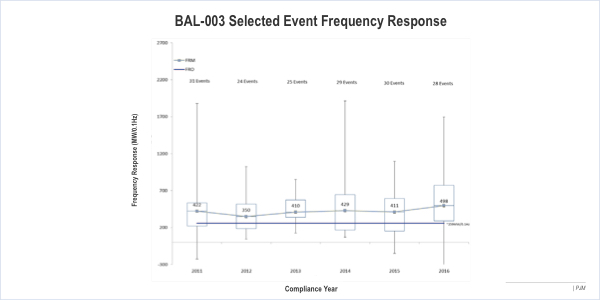VALLEY FORGE, Pa. — PJM has developed a load forecasting process that has improved the grid operator’s prediction accuracy, staff meteorologist Elizabeth Anastasio told stakeholders at a Jan. 11 Operating Committee meeting.
PJM purchases three weather forecasts from different vendors, Anastasio explained. Load forecasts based solely on the most accurate of the three created an average error of 1.91% in 2016.
Using its own, more comprehensive forecast process, PJM achieved an average 1.79% error rate during the same period.
Each day, PJM produces a forecast for the current day and the week ahead for 22 zones within its footprint, as well as for several aggregates and the entire RTO. Dispatchers can update forecasts at any time, and updates are published twice hourly at 15 minutes and 45 minutes past the start of the hour.
Initial forecasts are posted by 10 a.m. ET, before the close of the day-ahead market at 10:30 a.m. At 6 p.m., the current forecast update becomes the “original” forecast for the next day in members’ Data Viewer portal.
Dispatchers combine the weather forecasts with information about the day — such as the season or whether the day is a holiday — and historical load information to develop eight models. Several of them perform best on days with normal conditions, while others are most useful under specific circumstances.
“On average, the ensemble models are our best performers,” Anastasio said. “On holidays, a lot of these models are going to give you trouble.”
Unusual weather conditions, daylight saving time and a lack of information on load sources and likely human behavior can also contribute to forecast errors, Anastasio said. Dispatchers minimize those discrepancies in several ways, including by “backcasting” — a process used to determine what factors would have produced a perfect forecast and compare them with the factors that were actually used.
PJM is improving the process, she said, by combining the forecasts into a “smart mix,” creating better models, implementing a solar forecast, developing a load forecast analysis team and participating in industry forums on the topic.
“There’s a lot of things going on behind the scenes to make this better,” she said.
Manual 40 Revisions Approved with Exelon’s Addendum
Members endorsed PJM’s proposed Manual 40 changes that will reduce the grace period for completing operator training. The proposal had been updated from previous versions to include a phrase proposed by Exelon.
Exelon asked for language clarifying that the clock for the grace period begin only after the operator is “deemed qualified” by the employing company. PJM has proposed cutting the grace period in half to six months. (See “PJM Moves to Cut Operator-Training Grace Period in Half,” PJM Operating Committee Briefs.)
PJM plans for the new requirement to apply to anyone who begins training on Feb. 1 or later. Trainees who begin earlier than that date will remain subject to the 12-month grace period.
PJM Moves to Relax Refresh-Rate Standards
PJM plans to relax its telemetry scan rate requirements for internal special cases and transformer tie lines from four seconds to 10 seconds in proposed changes to Manual 1, PJM’s Ryan Nice explained.
However, he noted that if more than one regulation is involved, the more stringent standard still applies.
Emergency Procedure Messages Added
Two potential message types have been added as emergency procedure events: Conservative Operations and Synchronized Reserve Events, PJM’s Dave Hislop explained.
Conservative Operations might be declared when the RTO (or a portion of it) is undergoing, or has the potential to face, adverse impacts from a weather or environmental event and requires enhanced RTO reliability efforts, or if it enters an unknown operating state, such as an outage to its Energy Management System. PJM added this message type to any facilities that receive hot or cold weather alerts.
Synchronized Reserve Event notifications were removed from the system in 2012 because the events are usually of such a short nature that operators often posted the notification after the event had already been canceled. Members have asked them to be reinstated now that notifications are system-automated and posted immediately. The notifications will be sent for the reserve capability of generation units that can be converted into energy or demand response resources able to respond within 10 minutes. PJM added this message type to any facilities that receive primary reserve alerts.
PJM Satisfying Frequency Response Obligation
PJM’s field trial performance has exceeded its expected frequency response obligation (FRO) every year since NERC’s BAL-003 standard went into effect in 2011, PJM’s Danielle Croop said.
“We are well above our obligation in our performance measure,” she said.
The performance is measured as the median of all NERC-selected events. Of 28 events selected in 2016, PJM met or exceeded its obligation on all but five. PJM’s FRO for the 2017 operating year is -258.31 MW/0.1 Hz.
– Rory D. Sweeney



